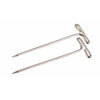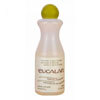Blocking. It remains a subject of discussion! Some find it unnecessary. Others see the benefits but are afraid to ruin their yarn in the process. I always block my crochet, as to me it's the final step of finishing a crochet piece.
It makes the difference between a piece that is done and a piece that is finished.
Just look at the drape of the Feather and Fan shawl. Believe me, it didn’t look like this when I wove in that final thread.
But I didn’t worry, because I knew how much blocking can do for the appearance and drape of crochet.
Why should I block my crochet or knit?
Blocking usually involves wetting your stitches with water (more on that later). By doing so, you will see a couple of changes:
- If you are blocking your work, you are redistributing the tension in your piece, in a good way. Some stitches will hold a bit more tension compared to other stitches, as that just happens when we crochet (we’re all human after all!). By soaking your piece in water or wetting it, the tension in the stitches is divided equally, making for a more even-looking piece with an increased stitch definition.
- Blocking also makes your piece much, much softer! When you crochet, you agitate your yarn slightly (by pulling loops through loops, which rubs some of the yarn the wrong way). When you are relaxing your fibres, your item immediately becomes more supple and softer.
- If you’re working with lace patterns or motifs that have spaces in between, blocking and stretching it will make the motifs or lacework in your piece much more visible and neater, as your item will not be ‘crumpled up’.
- You can work away small size inconsistencies and straighten out borders. We’ve all been there: an edging that doesn’t want to sit straight, or is a bit wavy, even though you follow the pattern. By blocking, you can work around these annoyances to a certain degree.
- Blocking helps you prevent colour bleeding. Sometimes, if you have a bright or dark colour next to a lighter colour, your colour might bleed into the lighter shade, due to excess dye in the yarn. This is such a waste of hard work! Thankfully, the risk of colour bleeding can be reduced by wet blocking your items.
Myths around blocking
As I’ve been a crocheter for a while now, I’ve heard and seen a couple of misconceptions about blocking that don’t seem to go away.
‘I don’t block, because after washing my hard work will be undone anyway.’
Nope, not true! Blocking relaxes the stitches, but it also ‘sets’ them in the way you want. Of course, when you wash your item and leave it as a crumpled mess to dry, your hard work will not show. But basically, every time you wash, you’re giving your item a small blocking treatment. When you leave it in shape to dry, you keep most of the benefits, such as relaxed fibres and softer yarn. What I recommend is ‘ironing’ your item with your hands. So gently stretch your piece into shape, smoothing out any creases before leaving it to dry naturally. It only takes a minute of your time!
‘I use acrylic fibers, they can’t be blocked’
That’s only half true. Acrylic consists of 100% manmade fibres and does not respond to blocking as well as natural fibres do. But acrylic yarns can certainly benefit from a proper blocking treatment! Although the piece won’t really get softer, blocking still helps you get an increased stitch definition and helps you get edges straight. In the end, it gives your piece an extra bit of ‘pow’!
‘I don’t block my items because they will felt.’
First of all, this can only happen with natural fibres. Acrylic fibres simply can’t be felt. If there’s an indication of ‘superwash’ yarn on your label, you also don’t have to be afraid of felting, as your yarn has been made washable (usually by adding a small amount of acrylic to the yarn). The felting of natural fibres only occurs when you have a combination of (warm) water, soap and agitation. During blocking, you don’t agitate the yarn, so no felting will occur if you’re gentle with your work.
Tools for blocking
If you’re looking for blocking supplies, I’ve listed them here. You don’t need all the blocking tools to start, but I’m sure you won’t regret having the ‘nice to haves’.
Necessary:
 | Blocking mats. The sturdy mats will help you pin down your work. (available on Wool Warehouse (UK) or Amazon). |
 | T-pins. I prefer T-pins over regular pins. They’re sturdier and easier to place. Whatever you choose, make sure they’re made out of stainless steel (available on Jimmy Beans Wool (US) or Wool Warehouse (UK) ). |
 | Eucalan, a leave-in yarn detergent. Technically not necessary, but I heavily recommend using it (available on Wool Warehouse (UK) and Jimmy Beans Wool (US) ). |
Nice to have:
 | Blocking wires. These will help you block larger items such as shawls and blankets. (available Wool Warehouse (UK) or Jimmy Beans Wool (US)). |
 | Rainbow Blockers. These will speed up your blocking process by placing multiple pins at one go (available at Wool Warehouse (UK) or Jimmy Beans Wool (US)). |
How to block your crochet?
Blocking comes in a variety of shapes, each one with its own pro’s and con’s. You have wet, spray, and steam blocking. To prevent this article from being too long, each method has its own page:
If you don’t know which method is suitable for your item, consider the following:
- You can wet block every fibre.
- You can spray block every fibre, but spray blocking doesn’t remove the excess dye from the yarn. So don’t use this method if you have used bright colours in your item.
- Steam blocking can be done with 100% cotton fibres, and when done carefully, with acrylic fibres too.
After-blocking care
So, after blocking (or making anything handmade in general), you want to take good care of your piece. There are a few things you might consider:
- Use a colour catcher. It doesn’t happen often, but sometimes your yarns will bleed. Especially when you use lighter and darker colours right next to each other, there’s a small chance of colour bleeds. To prevent this, you can add a colour catcher to your laundry. It’s good practice for washing anything handmade, really!
- When you wash your work, wash it by hand. It’s the least agitating for your yarn. If you don’t have the possibility to do so, choose the most gentle cycle on your machine (often wool wash) and prevent high temperatures. Acrylic can be washed on a regular low-temperature cycle, though.
- Let it dry naturally. Don’t put it in the dryer! It’s bad for most yarns, but also undoes a lot of your blocking work. Let it dry flat, ‘iron’ it in shape with your hands, and do not leave it in direct sunlight to prevent fading colours.
Blocking Large projects
I've written a special post about blocking large projects and the issues you might face. Give it a read here!





Comments